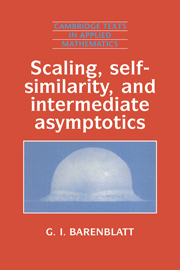 Scaling, Self-similarity, and Intermediate Asymptotics
Scaling, Self-similarity, and Intermediate Asymptotics Book contents
- Frontmatter
- Dedication
- Contents
- Preface
- Foreword
- Introduction
- 1 Dimensions, dimensional analysis and similarity
- 2 The construction of intermediate-asymptotic solutions using dimensional analysis. Self-similar solutions
- 3 Self-similarities of the second kind: first examples
- 4 Self-similarities of the second kind: further examples
- 5 Classification of similarity rules and self-similar solutions. A recipe for the application of similarity analysis
- 6 Scaling and transformation groups. Renormalization group
- 7 Self-similar solutions and travelling waves
- 8 Invariant solutions: asymptotic conservation laws, spectrum of eigenvalues, and stability
- 9 Scaling in the deformation and fracture of solids
- 10 Scaling in turbulence
- 11 Scaling in geophysical fluid dynamics
- 12 Scaling: miscellaneous special problems
- Afterword
- References
- Index
5 - Classification of similarity rules and self-similar solutions. A recipe for the application of similarity analysis
Published online by Cambridge University Press: 18 December 2014
- Frontmatter
- Dedication
- Contents
- Preface
- Foreword
- Introduction
- 1 Dimensions, dimensional analysis and similarity
- 2 The construction of intermediate-asymptotic solutions using dimensional analysis. Self-similar solutions
- 3 Self-similarities of the second kind: first examples
- 4 Self-similarities of the second kind: further examples
- 5 Classification of similarity rules and self-similar solutions. A recipe for the application of similarity analysis
- 6 Scaling and transformation groups. Renormalization group
- 7 Self-similar solutions and travelling waves
- 8 Invariant solutions: asymptotic conservation laws, spectrum of eigenvalues, and stability
- 9 Scaling in the deformation and fracture of solids
- 10 Scaling in turbulence
- 11 Scaling in geophysical fluid dynamics
- 12 Scaling: miscellaneous special problems
- Afterword
- References
- Index
Summary
Complete and incomplete similarity
In chapters 2–4 several instructive and fundamentally different self-similar problems were considered. In the problem of an instantaneous concentrated heat source and the problems of the propagation of very intense thermal and blast waves the situation turned out to be relatively simple. Namely, for them there exists some completely schematized idealized statement of the problem (energy release at a point, initial temperature and pressure equal to zero). Considering this statement of the idealized problem and applying the procedures of dimensional analysis to it in the standard way, we can reveal the self-similarity of the solution, construct the self-similar variables, and obtain the solution in finite form owing to the existence of certain integrals.
Deeper consideration shows, however, that this simplicity is illusory and that, for example, in making the assumption of pointwise release of energy we have, as it is said, gone to the brink of an abyss. In fact, by changing the formulation of the problem, apparently only slightly, in such a way that it would seem that all similarity considerations must preserve their validity, we arrived at a contradiction; it turned out that in the modified problems the required solutions simply do not exist. More detailed analysis showed that in trying to find solutions of the modified problems by the same standard procedure, and starting from the formulation of an idealized problem, it turned out that the very statement of the question was improper. What we actually needed was not exact solutions of the simply formulated idealized, degenerate problem, corresponding to the instantaneous removal at a plane of a finite mass of fluid or the instantaneous release at a point of a finite amount of energy. We were interested, rather, in the asymptotics of solutions of the corresponding non-idealized problems, the existence and uniqueness of whose solutions are either strictly proved or evoke no doubt; the non-idealized problems naturally turned out to be non-self-similar.
- Type
- Chapter
- Information
- Scaling, Self-similarity, and Intermediate AsymptoticsDimensional Analysis and Intermediate Asymptotics, pp. 145 - 160Publisher: Cambridge University PressPrint publication year: 1996
- 1
- Cited by
